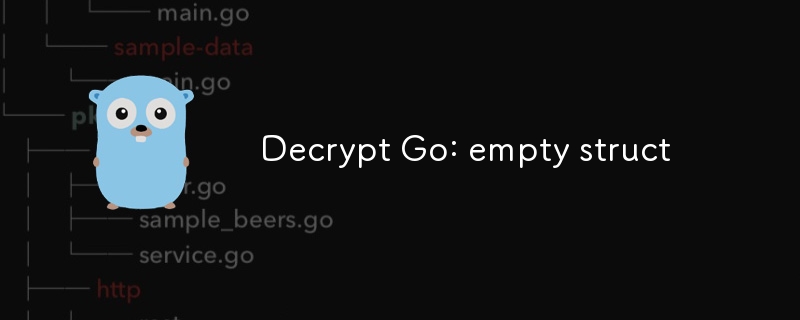解密Go:空結構

In Go, a normal struct typically occupies a block of memory. However, there's a special case: if it's an empty struct, its size is zero. How is this possible, and what is the use of an empty struct?
This article is first published in the medium MPP plan. If you are a medium user, please follow me in medium. Thank you very much.
type Test struct {
A int
B string
}
func main() {
fmt.Println(unsafe.Sizeof(new(Test)))
fmt.Println(unsafe.Sizeof(struct{}{}))
}
/*
8
0
*/
The Secret of the Empty Struct
Special Variable: zerobase
An empty struct is a struct with no memory size. This statement is correct, but to be more precise, it actually has a special starting point: the zerobase variable. This is a uintptr global variable that occupies 8 bytes. Whenever countless struct {} variables are defined, the compiler assigns the address of this zerobase variable. In other words, in Go, any memory allocation with a size of 0 uses the same address, &zerobase.
Example
package main
import "fmt"
type emptyStruct struct {}
func main() {
a := struct{}{}
b := struct{}{}
c := emptyStruct{}
fmt.Printf("%p\n", &a)
fmt.Printf("%p\n", &b)
fmt.Printf("%p\n", &c)
}
// 0x58e360
// 0x58e360
// 0x58e360
The memory addresses of variables of an empty struct are all the same. This is because the compiler assigns &zerobase during compilation when encountering this special type of memory allocation. This logic is in the mallocgc function:
//go:linkname mallocgc
func mallocgc(size uintptr, typ *_type, needzero bool) unsafe.Pointer {
...
if size == 0 {
return unsafe.Pointer(&zerobase)
}
...
This is the secret of the Empty struct. With this special variable, we can accomplish many functionalities.
Empty Struct and Memory Alignment
Typically, if an empty struct is part of a larger struct, it doesn't occupy memory. However, there's a special case when the empty struct is the last field; it triggers memory alignment.
Example
type A struct {
x int
y string
z struct{}
}
type B struct {
x int
z struct{}
y string
}
func main() {
println(unsafe.Alignof(A{}))
println(unsafe.Alignof(B{}))
println(unsafe.Sizeof(A{}))
println(unsafe.Sizeof(B{}))
}
/**
8
8
32
24
**/
When a pointer to a field is present, the returned address may be outside the struct, potentially leading to memory leaks if the memory is not freed when the struct is released. Therefore, when an empty struct is the last field of another struct, additional memory is allocated for safety. If the empty struct is at the beginning or middle, its address is the same as the next variable.
type A struct {
x int
y string
z struct{}
}
type B struct {
x int
z struct{}
y string
}
func main() {
a := A{}
b := B{}
fmt.Printf("%p\n", &a.y)
fmt.Printf("%p\n", &a.z)
fmt.Printf("%p\n", &b.y)
fmt.Printf("%p\n", &b.z)
}
/**
0x1400012c008
0x1400012c018
0x1400012e008
0x1400012e008
**/
Use Cases of the Empty Struct
The core reason for the existence of the empty struct struct{} is to save memory. When you need a struct but don't care about its contents, consider using an empty struct. Go's core composite structures such as map, chan, and slice can all use struct{}.
map & struct{}
// Create map
m := make(map[int]struct{})
// Assign value
m[1] = struct{}{}
// Check if key exists
_, ok := m[1]
chan & struct{}
A classic scenario combines channel and struct{}, where struct{} is often used as a signal without caring about its content. As analyzed in previous articles, the essential data structure of a channel is a management structure plus a ring buffer. The ring buffer is zero-allocated if struct{} is used as an element.
The only use of chan and struct{} together is for signal transmission since the empty struct itself cannot carry any value. Generally, it's used with no buffer channels.
// Create a signal channel
waitc := make(chan struct{})
// ...
goroutine 1:
// Send signal: push element
waitc <- struct{}{}
// Send signal: close
close(waitc)
goroutine 2:
select {
// Receive signal and perform corresponding actions
case <-waitc:
}
In this scenario, is struct{} absolutely necessary? Not really, and the memory saved is negligible. The key point is that the element value of chan is not cared about, hence struct{} is used.
Summary
- An empty struct is still a struct, just with a size of 0.
- All empty structs share the same address: the address of zerobase.
- We can leverage the empty struct's non-memory-occupying feature to optimize code, such as using maps to implement sets and channels.
References
- The empty struct, Dave Cheney
- Go 最细节篇— struct{} 空结构体究竟是啥?
以上是解密Go:空結構的詳細內容。更多資訊請關注PHP中文網其他相關文章!

熱AI工具

Undresser.AI Undress
人工智慧驅動的應用程序,用於創建逼真的裸體照片

AI Clothes Remover
用於從照片中去除衣服的線上人工智慧工具。

Undress AI Tool
免費脫衣圖片

Clothoff.io
AI脫衣器

Video Face Swap
使用我們完全免費的人工智慧換臉工具,輕鬆在任何影片中換臉!

熱門文章

熱工具

記事本++7.3.1
好用且免費的程式碼編輯器

SublimeText3漢化版
中文版,非常好用

禪工作室 13.0.1
強大的PHP整合開發環境

Dreamweaver CS6
視覺化網頁開發工具

SublimeText3 Mac版
神級程式碼編輯軟體(SublimeText3)
 Golang的目的:建立高效且可擴展的系統
Apr 09, 2025 pm 05:17 PM
Golang的目的:建立高效且可擴展的系統
Apr 09, 2025 pm 05:17 PM
Go語言在構建高效且可擴展的系統中表現出色,其優勢包括:1.高性能:編譯成機器碼,運行速度快;2.並發編程:通過goroutines和channels簡化多任務處理;3.簡潔性:語法簡潔,降低學習和維護成本;4.跨平台:支持跨平台編譯,方便部署。
 Golang和C:並發與原始速度
Apr 21, 2025 am 12:16 AM
Golang和C:並發與原始速度
Apr 21, 2025 am 12:16 AM
Golang在並發性上優於C ,而C 在原始速度上優於Golang。 1)Golang通過goroutine和channel實現高效並發,適合處理大量並發任務。 2)C 通過編譯器優化和標準庫,提供接近硬件的高性能,適合需要極致優化的應用。
 Golang vs. Python:主要差異和相似之處
Apr 17, 2025 am 12:15 AM
Golang vs. Python:主要差異和相似之處
Apr 17, 2025 am 12:15 AM
Golang和Python各有优势:Golang适合高性能和并发编程,Python适用于数据科学和Web开发。Golang以其并发模型和高效性能著称,Python则以简洁语法和丰富库生态系统著称。
 Golang vs. Python:性能和可伸縮性
Apr 19, 2025 am 12:18 AM
Golang vs. Python:性能和可伸縮性
Apr 19, 2025 am 12:18 AM
Golang在性能和可擴展性方面優於Python。 1)Golang的編譯型特性和高效並發模型使其在高並發場景下表現出色。 2)Python作為解釋型語言,執行速度較慢,但通過工具如Cython可優化性能。
 表演競賽:Golang vs.C
Apr 16, 2025 am 12:07 AM
表演競賽:Golang vs.C
Apr 16, 2025 am 12:07 AM
Golang和C 在性能競賽中的表現各有優勢:1)Golang適合高並發和快速開發,2)C 提供更高性能和細粒度控制。選擇應基於項目需求和團隊技術棧。
 Golang的影響:速度,效率和簡單性
Apr 14, 2025 am 12:11 AM
Golang的影響:速度,效率和簡單性
Apr 14, 2025 am 12:11 AM
goimpactsdevelopmentpositationality throughspeed,效率和模擬性。 1)速度:gocompilesquicklyandrunseff,IdealforlargeProjects.2)效率:效率:ITScomprehenSevestAndardArdardArdArdArdArdArdArdArdArdArdArdArdArdArdArdArdArdArdArdArdArdArdArdArdArdArdArdArdArdArdArdArdArdArdArdArdArdEcceSteral Depentencies,增強的Depleflovelmentimency.3)簡單性。
 C和Golang:表演至關重要時
Apr 13, 2025 am 12:11 AM
C和Golang:表演至關重要時
Apr 13, 2025 am 12:11 AM
C 更適合需要直接控制硬件資源和高性能優化的場景,而Golang更適合需要快速開發和高並發處理的場景。 1.C 的優勢在於其接近硬件的特性和高度的優化能力,適合遊戲開發等高性能需求。 2.Golang的優勢在於其簡潔的語法和天然的並發支持,適合高並發服務開發。
 Golang和C:性能的權衡
Apr 17, 2025 am 12:18 AM
Golang和C:性能的權衡
Apr 17, 2025 am 12:18 AM
Golang和C 在性能上的差異主要體現在內存管理、編譯優化和運行時效率等方面。 1)Golang的垃圾回收機制方便但可能影響性能,2)C 的手動內存管理和編譯器優化在遞歸計算中表現更為高效。






